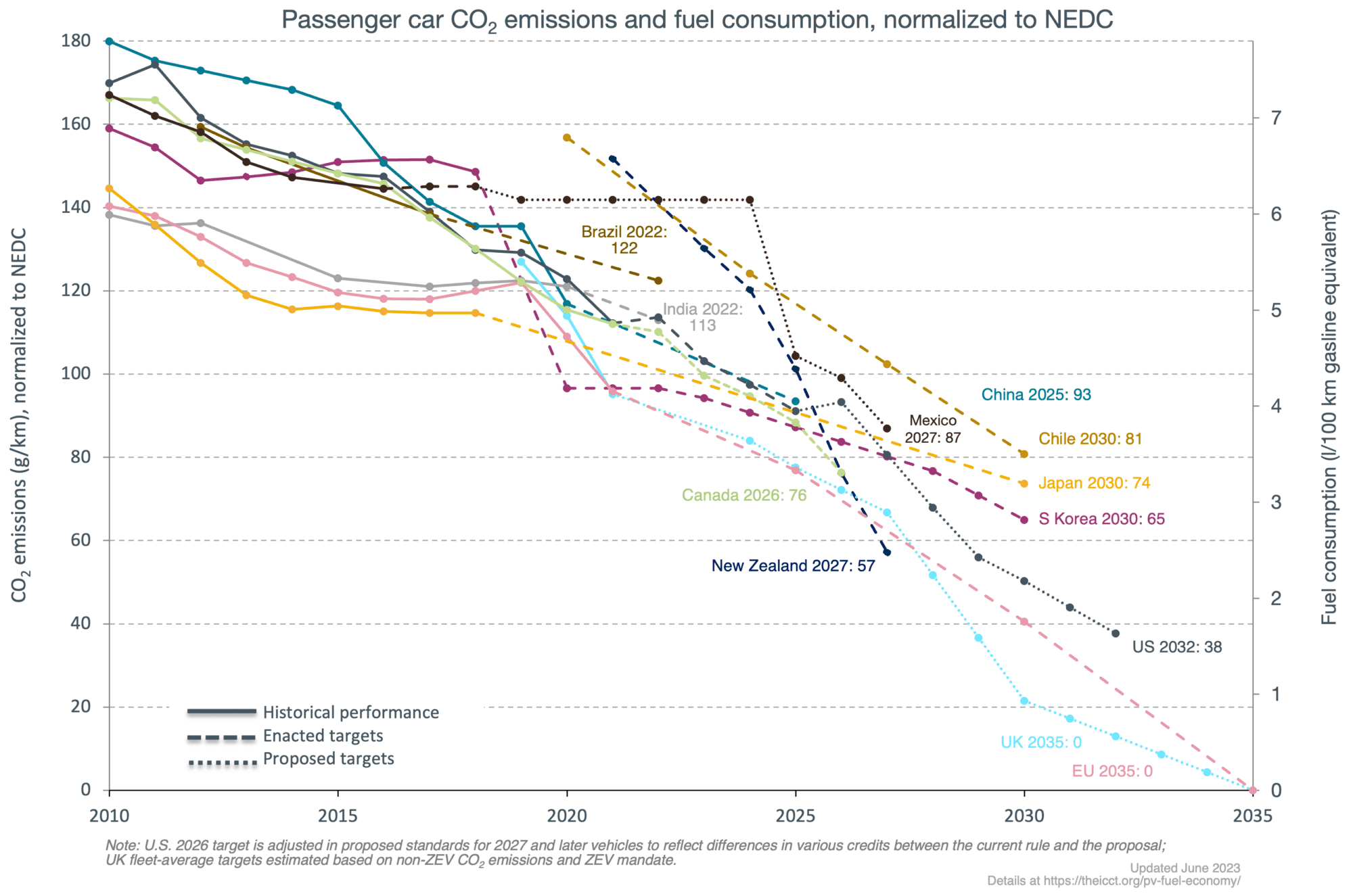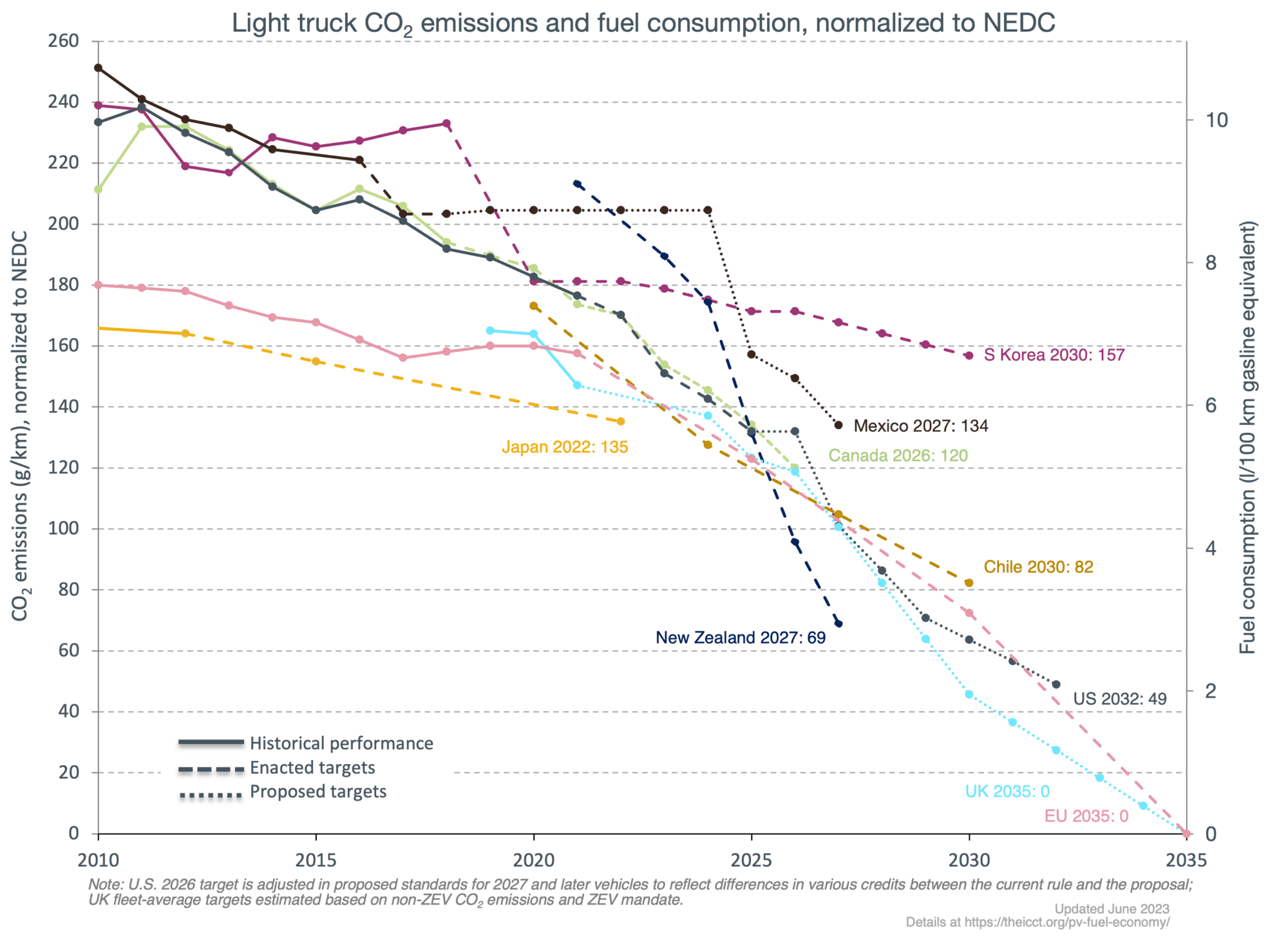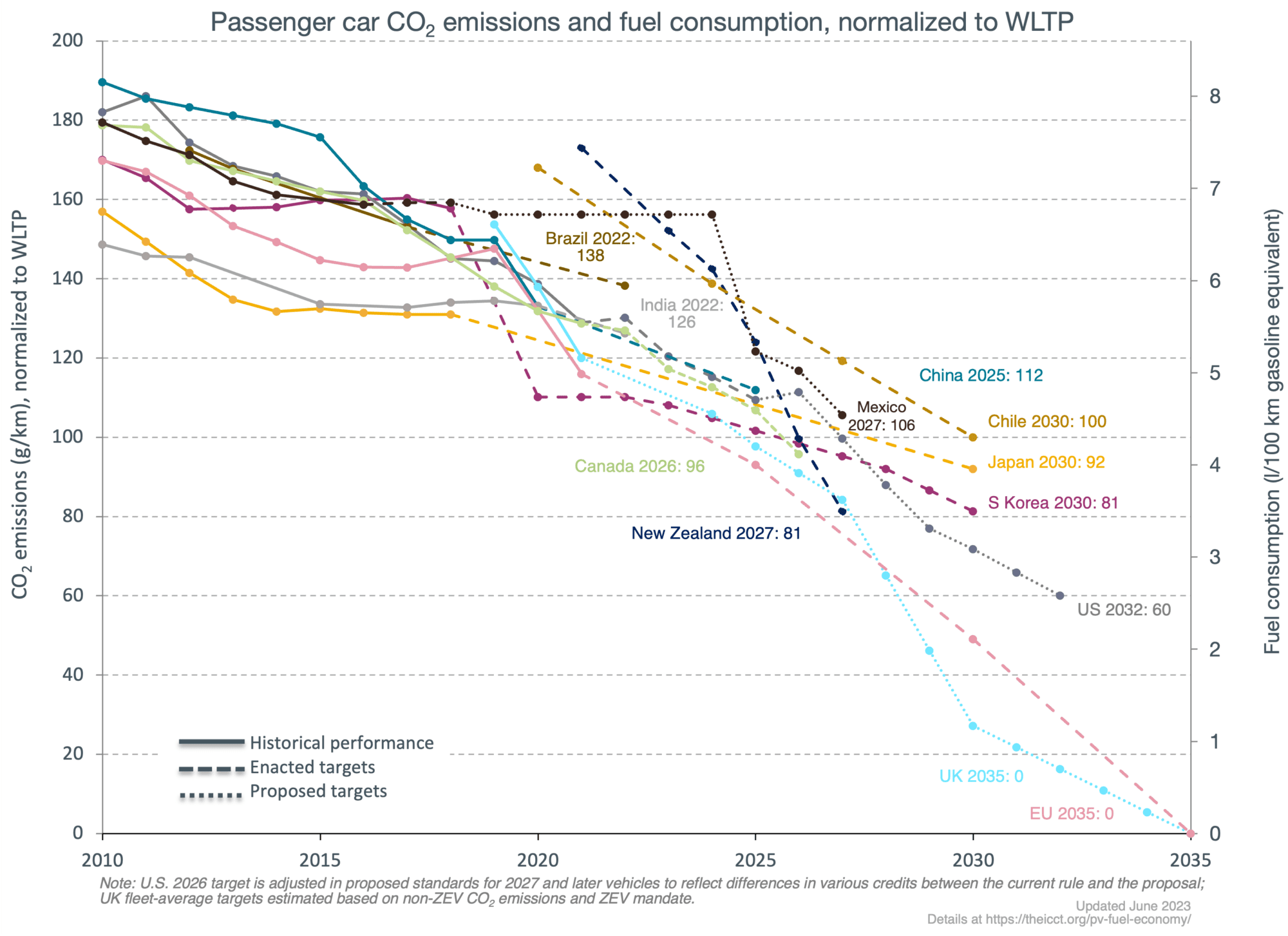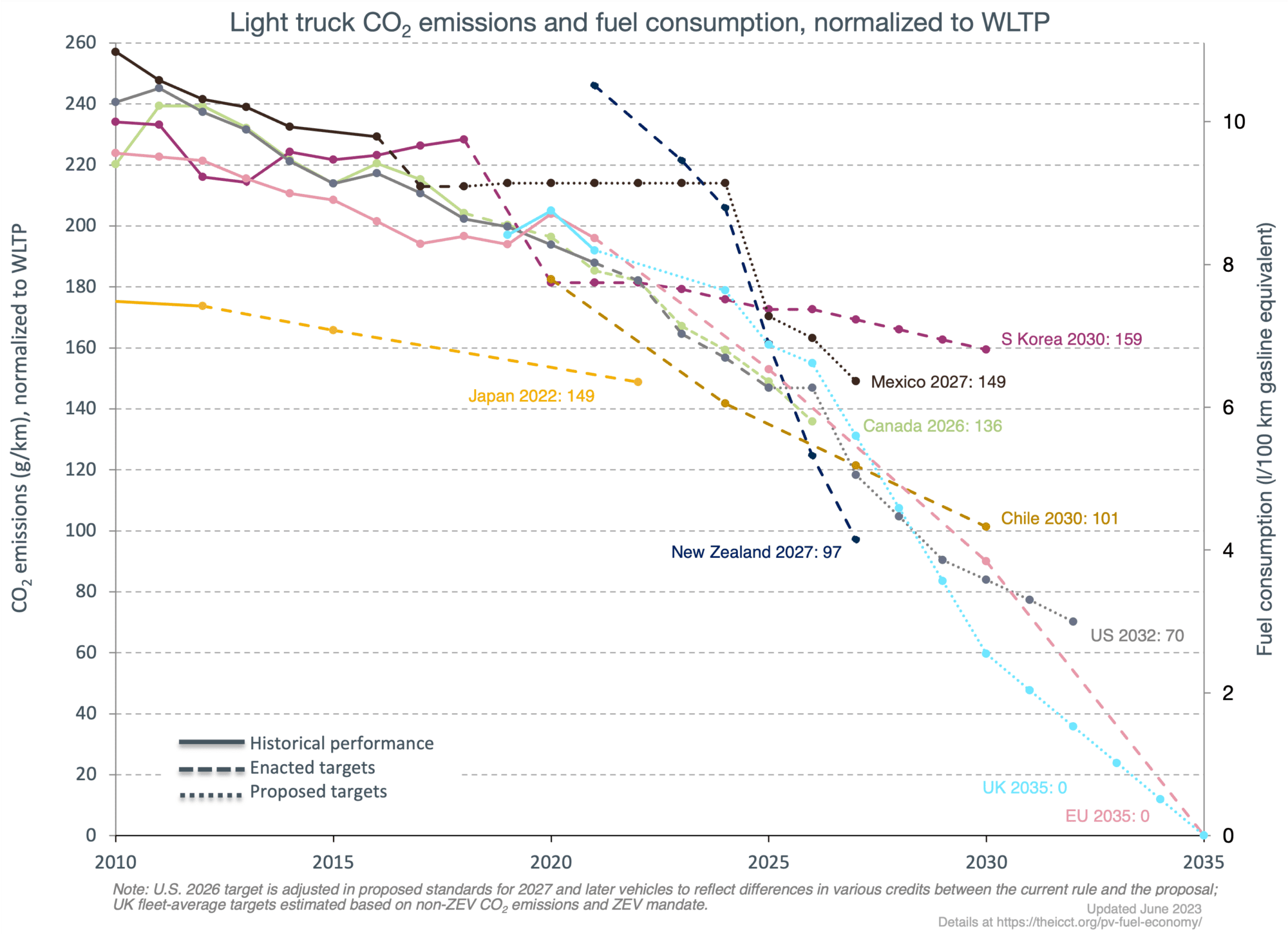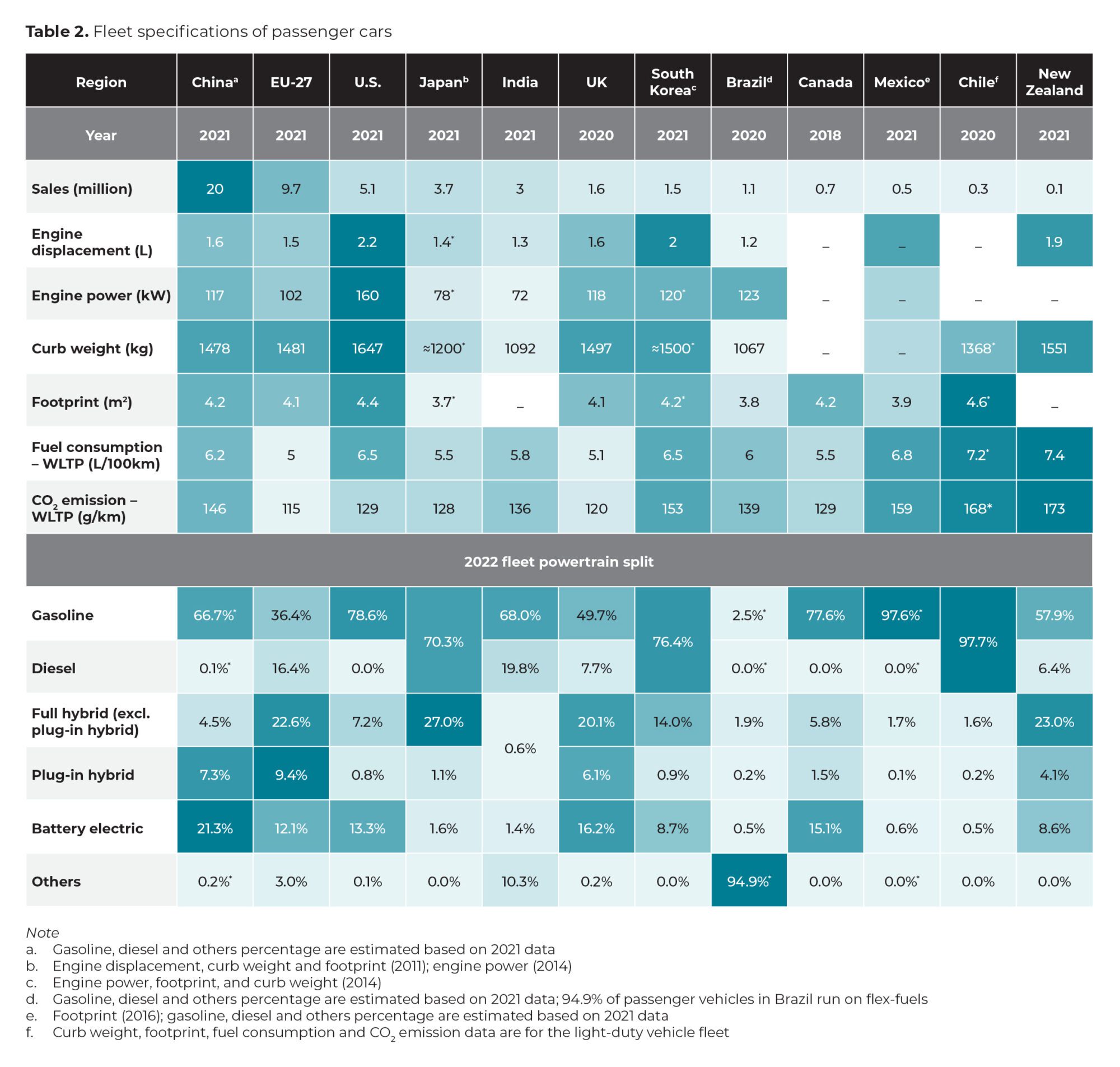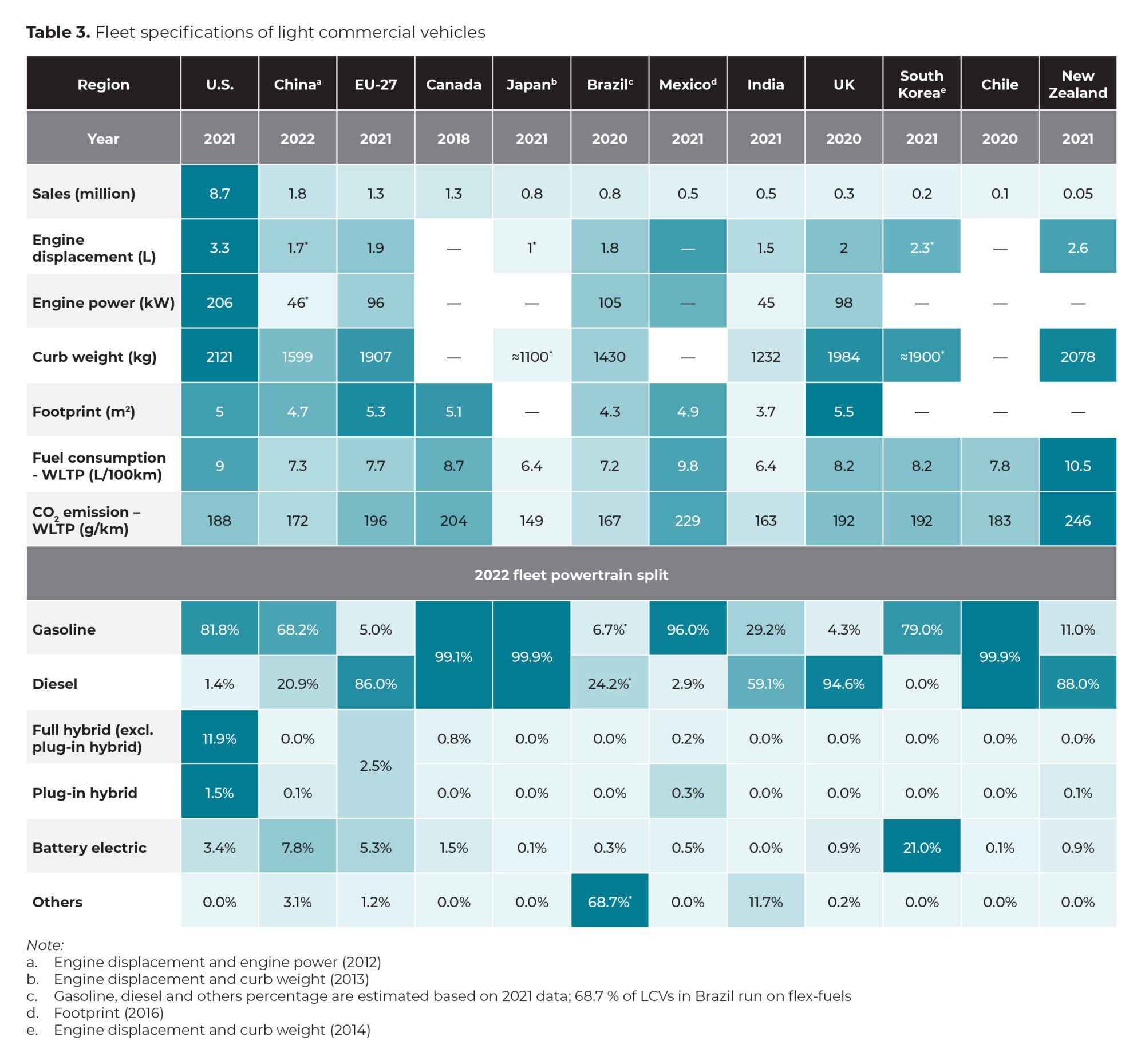Passenger vehicle greenhouse gas emissions and fuel consumption
Twelve countries worldwide have established or proposed fuel efficiency or greenhouse-gas emission standards for passenger vehicles and light commercial vehicles and trucks. The regulations in these markets, covering more than 85 percent of global passenger vehicle sales, influence the business decisions of major vehicle manufacturers around the world, and are among the most effective climate-change mitigation measures to have been implemented over the past decade.
These governments have taken differing approaches to designing their regulations, using different drive cycles and vehicle certification test procedures. Converting the standard values—that is, the fuel efficiency mandates or emissions limits—between different regulations involves not just converting physical units but also accounting for the impacts of differences in test cycles.
Since 2007, the ICCT has maintained a set of data tables, comparison charts, and a conversion tool as a ready reference to worldwide passenger vehicle fuel efficiency standards, with the aim of comparing the relative stringency of regulations as accurately and fairly as possible. The increasingly urgent need for effective policies on climate change mitigation and energy efficiency has only underscored the importance of accessible, reliable, and fair benchmarking across jurisdictions.
In 2014 we comprehensively updated the methodology underlying those resources. See the summary overview of those updates, and a detailed description of the methodology to learn more. The results are reflected in our library of comparison charts, and in the modified Excel-based conversion tool (links below). In 2017 we released a comprehensive report that updates the fuel efficiency policy of major vehicle markets. Future policy changes will be noted on our factsheets for each market (see below).
For more information contact: Zifei Yang, Program Lead
Comparison Charts
Updated July 2023
Overview of fuel efficiency and CO2 emission standards of passenger cars and light-commercial vehicles around the world
Updated August 2023
Table 1. Definitions of passenger car and light truck/commercial vehicles
| Region | Passenger Car | Light Truck/Commercial Vehicle | ||
|---|---|---|---|---|
| Max. GVW | Max. Seats | Max. GVW | Others | |
| EU | 3,500 kg | 9 | 3,500 kg | |
| China | 3,500 kg | 9 | 3,500 kg | Include passenger cars with seats > 9 |
| U.S. | 3,856 kg | 10 | 3,856 kg | GVW > 2722 kg including vehicles with four-wheel drive and meet various off-road requirements e.g., ground clearance |
| Canada | 3,856 kg | 10 | 3,856 kg | GVW > 2722 kg including vehicles with four-wheel drive and meet various off-road requirements e.g., ground clearance |
| India | 3,500 kg | 9 | 3,500 kg | |
| Brazil | 3,856 kg | 12 | 3,856 kg | Compact SUVs are classified as passenger cars, other SUVs including off-road and large SUVs are classified as a third separate category |
| South Korea | 3,500 kg | 10 | 3,500 kg | |
| UK | 3,500 kg | 9 | 3,500 kg | |
| New Zealand | 3,500 kg | 9 | 3,500 kg | Include vans with seats > 9 |
| Mexico | 3,857 kg | 10 | 3,856 kg | |
| Japan | 3,500 kg | / | 3,500 kg | |
| Chile | 2,700 kg | / | 2,700 kg | |
Table 2. Fleet specifications of passenger cars
Table 3. Fleet specifications of light commercial vehicles
Table 4. Overview of regulations for passenger cars
| Region | Target Year | Regulated Metric | Unadjusted Fleet Target/Measure | Attribute-based | Corporate Average | Test Cycle |
|---|---|---|---|---|---|---|
| EU | 2025 2030 2035 | CO2 | 93 g/km 49 g/km 0 g/km | Curb Weight | Yes | WLTP |
| China | 2021 - 2025 | Fuel consumption | 5.7 - 4.6 l/100km | Curb Weight | Yes | WLTP |
| U.S. | 2024 - 2026 | Fuel economy | 49.2 - 58.1 mpg 60.0 - 66.4 mpg | Footprint | Yes | U.S. combined |
| U.S. | 2023 - 2026 2027 - 2032 (proposal) | GHG | 166 - 132 g/mi 134 - 73 g/m mpg | Footprint | Yes | U.S. combined |
| Canada | 2023 - 2026 | GHG | 161 - 148 g/mi | Footprint | Yes | U.S. combined |
| India | FY 2022 - 2023 | Fuel consumption | 4.77 l/100km | Curb Weight | Yes | NEDC |
| Brazil | 2022 | Energy consumption | 1.62 MJ/km | Curb Weight | Yes | U.S. combined |
| South Korea | 2021 - 2030 | GHG | 97 - 70 g/km | Curb Weight | Yes | U.S. combined |
| UK | 2024 - 2035 (proposal) | CO2 | 120 - 0 g/km | Flat targets for ICE vehicles | Yes | WLTP |
| New Zealand | 2023 - 2027 | CO2 | 145 - 63.3 g/km | Tare Weight | Yes | 3P-WLTP |
| Mexico | 2025 - 2027 (proposal) | GHG | 104.4 - 88.9 g/km | Footprint | Yes | U.S. combined |
| Japan | 2030 | Fuel efficiency | 25.4 km/l | Curb Weight | Yes | 3P-WLTP |
| Chilea | 2024 - 2026 2027 - 2029 2030 | Fuel efficiency | 18.8 km/l 22.8 km/l 28.9 km/l | Curb Weight | Yes | WLTP |
(a) Fuel economy targets will be applied to the whole light-duty vehicle fleet
Table 5. Overview of regulations for light commercial vehicles
| Region | Target Year | Regulated Metric | Unadjusted Fleet Target/Measure | Attribute-Based | Corporate Average | Test Cycle |
|---|---|---|---|---|---|---|
| EU | 2025 2030 2035 | CO2 | 153 g/km 90 g/km 0 g/km | Curb Weight | Yes | WLTP |
| China | 2026 - 2030 (proposal) | Fuel consumption | N1: 7.3 - 5.9 l/100km M2: 8.2 - 6.6 l/100km | Test Weight | Yes | WLTP |
| U.S. | 2024 - 2026 2027- 2032 (proposal) | Fuel economy | 35.1 - 41.5 mpg 44.4 - 54.4 mpg | Footprint | Yes | U.S. combined |
| U.S. | 2023 - 2026 2027 - 2032 (proposal) | GHG | 234 - 187 g/mi 163 - 89 g/mi | Footprint | Yes | U.S. combined |
| Canada | 2023 - 2026 | GHG | 238 - 190 g/mi | Curb Weight | Yes | U.S. combined |
| Brazil | 2022 | Energy consumption | Off-road and large SUVs: 2.04 MJ/km | Curb Weight | Yes | U.S. combined |
| Brazil | 2022 | Energy consumption | Light commercial vehicles: 2.68 MJ/km | Curb Weight | Yes | U.S. combined |
| South Korea | 2021 - 2030 | GHG | 166 - 146 g/km | Curb Weight | Yes | U.S. combined |
| UK | 2024 - 2035,br.(proposal) | CO2 | 192 - 0 g/km | Flat targets for ICE vehicles | Yes | WLTP |
| New Zealand | 2023 - 2027 | CO2 | 218.3 - 87.2 g/km | Curb Weight | Yes | 3P-WLTP |
| Mexico | 2025 - 2027 (proposal) | GHG | 151.1 - 130.7 g/km | Footprint | Yes | U.S. combined |
| Japan | 2022 | Fuel efficiency | 17.9 km/l | Weight-class | Bin-based | JC08 |
| Chilea | 2024 - 2026 2027 - 2029 2030 | Fuel efficiency | 18.8 km/l 22.8 km/l 28.9 km/l | Curb Weight | Yes | WLTP |
(a) Fuel economy targets will be applied to the whole light-duty vehicle fleet.
Table 6. Credit banking and trading systems
| Region | Rule | Carry Forward | Carry Backward |
|---|---|---|---|
| China | Accumulate the exceedance as credit Transfer between related manufacturers Trade between manufacturers | 3 Years (With a 90% discount) | 120 days |
| U.S. | Accumulate the exceedance as credit Transfer between passenger cars and light trucks (unlimited for GHG, limited to 2.0 mpg for fuel economy) Trade between manufacturers Adjustment and extension factors apply | 5 Years | 3 Years |
| South Korea | Accumulate the exceedance as credit Trade between manufacturers Small-scale manufacturers are excluded | 5 Years from 2021 | / |
| UK (proposal) | Accumulate the exceedance as credit Trade between manufacturers Transfer exceedance to ZEV mandate scheme (2024–2026 only, with cap) | 3 Years | |
| New Zealand | Accumulate the exceedance as credit Transfer between passenger light vehicle importers | 3 Years | 1 Year (PVs only) |
| Mexico (proposal) | Accumulate the exceedance as credit Trade between manufacturers | Not defined in the proposal | 8 Years (2019 - 2027) |
Table 7. Overview of off-cycle credit system in passenger car fuel economy standards
| Region | Technology | Max. Credit |
|---|---|---|
| EU | Eco-innovation technologies: LED lights, 48V motor generator with DC/DC converter, alternator, 12V motor generator, and smart diesel fuel heater | 7 g/km (before 2025) 6 g/km (2025-2029) 4 g/km (2030-2034) Internal combustion engine vehicles (ICEVs) only |
| China | Kinetic Energy Recovery System (KERS) | 0.15 l/100km |
| High-efficiency A/C | 0.20 l/100km | |
| U.S. | 16 menu off-cycle technologies and additional technologies upon application | 10 g/mi (pre MY 2023) 15 g/mi (MY 2023-2026) 10 to 0 g/mi, EVs excluded (MY 2027-2032 proposal) |
| A/C refrigerant leakage/alternative refrigerant | 6.3 g/mi or 13.8 g/mi (whichever is higher) (before MY 2027) | |
| A/C efficiency | 5.0 g/mi EVs excluded (MY 2027-2032 proposal) |
|
| India | Regenerative breaking | 9 g/km |
| Start-Stop System | ||
| Tire pressure monitoring system | ||
| 6 or more Speed Transmission | ||
| Brazil | Start-Stop System | PVs: 0.227 MJ/km LCVs: 0.0439 MJ/km |
| Front grille control system | 0.0049 MJ/km | |
| Gear Shift Indicator (GSI) | 0.0134 MJ/km | |
| Tire Pressure Monitoring System (TPMS) | 0.0134 MJ/km | |
| High efficiency lights (LEDs) | 0.0079 MJ/km | |
| South Korea | Tire Pressure Monitoring System (TPMS) | 17.9 g/km or 4.5km/l |
| Low friction tires | ||
| Gear Shift Indicator (GSI) | ||
| High-efficiency A/C | ||
| Other technologies | ||
| UK | Eco-innovation technologies: LED lights, 48V motor generator with DC/DC converter, alternator, 12V motor generator, and smart diesel fuel heater | 7 g/km |
| Mexico (proposal) | Off-cycle credits (menu technology and additional technology upon approval) | 6.25 g/km |
| High efficiency lights | 0.36 g/km | |
| Active aerodynamic improvements | 1.2 g/km | |
| Heat recovery technology | 1.55 g/km | |
| Engine with stop-start system | 1.15 g/km | |
| Active engine heating system | 1.1 g/km | |
| Active transmission heating system | 1.21 g/km | |
| Thermal controls | 1.9 g/km | |
| Solar panels | 1.6 (battery charge + active cabin ventilation 75w) 2.0 g/km (battery charge 75w) |
|
| Tire Pressure Monitoring System (TPMS) | 0.6 g/km | |
| Electric heater circulation system | 1.92 g/km | |
| A/C refrigerant leakage | 4.12 g/km (MY 2025 – 2027 only) | |
| A/C refrigerant leakage/alternative refrigerant | 9.04 g/km (MY 2025 – 2027 only) | |
| A/C efficiency; 8 menu off-cycle technologies | 6.22 g/km (MY 2025 – 2027 only) |
Table 8. Overview of different vehicle super credit systems in vehicle fuel economy standards
| Region | Target year | Multiplier | Qualified vehicles | Note |
|---|---|---|---|---|
| EU | 2020 | 2 | CO2 ≤50 g/km (NEDC) | Up to 7.5 g/km over the three-year period from 2020-2022 |
| 2021 | 1.67 | |||
| 2022 | 1.33 | |||
| 2023 | 1 | |||
| China | 2021 | 2 | Battery electric vehicles (BEVs)/Plug-in hybrid electric vehicles (PHEVs) (mileage ≥ 43 km) | |
| 2022 | 1.8 | |||
| 2023 | 1.6 | |||
| 2024 | 1.3 | |||
| 2025 | 1 | |||
| 2021 | 1.4 | Non-EVs < 3.2 l/100km | ||
| 2022 | 1.3 | |||
| 2023 | 1.2 | |||
| 2024 | 1.1 | |||
| 2025 | 1 | |||
| U.S. | 2023-2024 | 1.5 | BEVs and Fuel cell vehicles (FCVs) | Up to 10.0 g/mi over MYs 2022–2025 |
| 2025 and later | 1 | |||
| 2023-2024 | 1.3 | PHEVs | ||
| 2025 and later | 1 | |||
| Canada | 2020 | 2.25 | BEVs and FCVs | |
| 2021 | 2 | |||
| 2022-2025 | 1.5 | |||
| 2020 | 1.95 | PHEVs | ||
| 2021 | 1.8 | |||
| 2022-2025 | 1.3 | |||
| 2020 | 1.45 | Natural gas vehicles | Including dual fuel vehicles | |
| 2021 | 1.3 | |||
| 2022-2025 | 1 | |||
| India | 2022-2023 | 2 | Hybrid electric vehicles (HEVs) | |
| 2.5 | PHEVs | |||
| 3 | BEVs | |||
| South Korea | 2021-2023 | 3 | BEVs and FCVs | Multiplier for compact vehicles is reduced by 0.3 Vehicles with manual transmissions receive 5.4 g/km reduction LPG vehicles receive 5% - 10% GHG emissions reduction by 2027 with a cap of 15 g/km |
| 2024 | 2.5 | |||
| 2025 | 2 | |||
| 2026 | 1.5 | |||
| 2027-2030 | 1 | |||
| 2021-2023 | 2 | HEVs and PHEVs | ||
| 2024 | 1.75 | |||
| 2025 | 1.5 | |||
| 2026 | 1.25 | |||
| 2027-2030 | 1 | |||
| UK | 2020 | 2 | CO2 ≤50 g/km | Up to 3.75 g/km over the two-year period from 2021 to 2022 |
| 2021 | 1.67 | |||
| 2022 | 1.33 | |||
| Mexico | 2019 - 2024 | / | BEVs, FCVs, HEVs, PHEVs, and ICEVs with emissions 20% below the annual limit | 1.8 g/km reduction |
| 2025 - 2027 | 13.5 | BEVs and FCVs | The OEM determines the number of sales be multiplied within the range of 0-50% of total sales of EVs, PHEVs and HEVs. | |
| 8.3 | PHEVs | |||
| 5 | HEVs |
Table 9. Derogations for small manufacturers
| Region | Definition of Small Manufacturers | Flexibility Mechanism |
|---|---|---|
| EU | <10,000 new passenger cars <22,000 new light commercial vehicles | Based on proposed specific emissions target consistent with the economic and technological potential to reduce CO2 emissions Manufacturers with < 1,000 new passenger cars or new light commercial vehicles annual sales are exempted from CO2 emissions standards |
| China | < 2,000 annual production or imports | 2021–2023: If the CAFC drops by 4% compared to the previous year, the CAFC standard is relaxed by 60%; If the CAFC drop is between 2%–4%, the CAFC standard is relaxed by 30% |
| U.S. | ≤ 1,500 employees | Exempted from GHG standards |
| Canada | < 750 LDV annual production or imports, calculated as a three-year rolling average | Exempted from GHG standards |
| India | ≤ 5,000 manufactured/imported units | Small manufacturers opting for alternate target, the target ‘T’ is calculated as below: 2017 - 2021: T = P (proposed target) 2022 – 2023: T = P * 0.830 |
| Korea | ≤ 4,500 automobile sales in 2009 | A relaxed standard of 8% (2021-2022), 10% (2023), 11% (2024), 14% (2025- 2026), 13% (2027), 12% (2028), 11% (2029), and 10% (2030) |
| Korea | ≤ 500 automobile sales in 2009 | The government established a specific target in consultation with the manufacturer |
| UK | < 1,000 new passenger cars or new light commercial vehicles annual sales | Exempted from CO2 emissions standards |
| New Zealand | No special treatment | No special treatment |
| Mexico (proposal) | ≤ 500 vehicle sales | Exempted from GHG emissions standards |
Table 10. Fuel efficiency and GHG standards regulatory agencies and document
Quick Resources
Links to country-specific information in fact sheets and on transportpolicy.net
